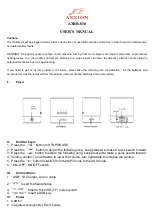
5.1 Home Theater Placement
Optimizing A Theater Set-Up For Surround Sound
Home theater and multi-channel music has introduced a new
speaker configuration to home audio. Instead of the large floor
mounted stereo speakers of the ‘70’s and 80’s, your Aperion Audio
sound system is comprised of 5 smaller satellite or bookshelf
speakers designed to carry mid-range and upper tones, with a
separately powered subwoofer to handle the lower bass frequencies.
These speakers are arranged around the listener in an array with
3 speakers in the front and 2 in the rear.
There are no ideal positions for home theater and stereo components
that will work for every room. The acoustic properties of any
room, unless it was specifically designed to be a home theater,
are not perfect, and each room is unique. Start with the following
guidelines for setting up your speakers, but don’t be afraid to
experiment. Often a small difference in placement can yield a big
improvement in sound.
·
Be aware that many bare surfaces in a room can add harshness
to the sound or muddy the dialogue. Sound absorbing surfaces
like carpeting and drapes will help.
·
Perfectly square rooms, or rooms where one dimension is
exactly twice another can cause unwanted resonance that
color the sound.
·
If possible, the seating area should be centered between the
sidewalls.
·
For the best bass, try not to place your seating area so that
it is against a wall, or at a position that is 1/2 or 1/4 the
room's width or length.
·
A speaker’s bass output grows stronger the closer a speaker
is placed to the corners. If a speaker is placed too close to a
corner it can sound unbalanced.
·
Aperion Audio speakers will work together better and create
a more precise soundstage (a system’s ability to recreate the
original recording room and placement of the instruments in
space) if the left, right and center speakers are not placed
directly against a wall.
5









































